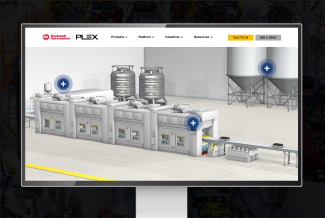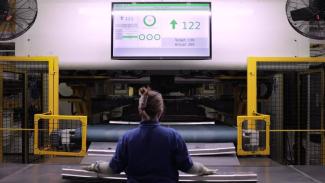The Rise of Automation in Manufacturing
Watch a DemoIn the last couple of years, unprecedented disruptions in manufacturing have resulted in lots of shifting and pivoting on the plant floor. It may come with little surprise that manufacturing leaders now more than ever are striving for ways to improve their processes to drive greater throughput and reduce costs. This ongoing desire for both cost-cutting and increased efficiency is prime for manufacturers who are looking to adapt more automation technology in the realm of Industry 4,0 for successful outcomes. In this article, we’ll explore the rise of automation in manufacturing and how it can help businesses meet critical production monitoring KPIs. We’ll also outline how to successfully implement different types of automation into your internal processes.
What is Industrial Automation?
Automation, in the context of manufacturing, is generally thought of as using equipment to automate systems or production processes to increase efficiency and reduce the requirement of any manual input. Automation can assist in speeding up production and greatly reducing costs as processes will reduce the amount of manual labor from employees, allowing them to focus their expertise on strategic oversight of their assigned function.
Industrial automation involves using machines to carry out work normally performed by humans. It has become associated with electromechanical systems that are programmed to perform different tasks and processes. Industrial automation may not always be a solution for manufacturers, but most companies can benefit from using one of the many different types of automation, which we cover in more detail below.
There are three different types of industrial automation systems:
Types of Automation in Manufacturing
-
Fixed Automation
Also known as ‘hard automation’, ‘fixed automation refers to a system that has a fixed task and is not easily changed from one product style to another. It is characterized by high production rates and a high barrier to entry. The programming is contained within the machines in the form of cams, gears, wiring and other hardware. Fixed automation is suitable for products that are made in large volume—a good example would be machining transfer lines found in the automotive industry, automatic assembly machines and specific chemical processes. Changeovers can occur, but it would require a line to be shut down and for technicians to manually swap tooling.
-
Programmable Automation
Programmable automation is used by manufacturers to produce products in batches. These batches can range from a few dozen products to several thousand. Each time the production equipment must be reprogrammed and changed to accommodate new product specifics; this requires downtime. Programmable automation has generally lower production rates than fixed automation, but this is simply because equipment is designed to facilitate product changeover. The cost of lengthy downtime has led to an extension of programmable automation known as flexible automation.
-
Flexible Automation
The key disadvantage with programmable automation is the downtime that occurs when equipment is changed to accommodate new products. Flexible automation is an extension designed to overcome this problem. It does this by performing changeovers automatically, the downside is it can limit equipment to run parts that share similar tools or require additional devices to make changeovers possible. This means the variety of products is much smaller with flexible automation in order to ensure this automatic changeover can be done quickly. Since programs need to be changed, flexible automation is often connected to a network. This adds value because it means that manufacturers can operate production remotely. Flexible automation also means products are no longer produced in batches as a mixture of products can be made simultaneously.
Examples of Automation Used in Manufacturing
In this section, we’ll look at different examples of automated production processes, which could help you and your business identify which type of automation your manufacturing could benefit from.
Examples of Fixed Automation
Fixed automation is best for fast production of a singular style of product. Here are some examples:
- Automated assembly machines
- Chemical manufacturing processes
- Material handling conveyor systems
- Machining transfer lines
- Paint & coating automation processes
- Web Handling and converting systems
Examples of Programmable Automation
Programmable automation is best for manufacturers making batches of different products. Examples include:
- Numerically controlled (NC) machine tools
- Programmable logic controllers (PLCs)
- Industrial robots
- Production of frozen foods
Examples of Flexible Automation
Flexible automation is best for producing a variety of similar products quickly and performing changeovers automatically. The best example of flexible automation is a robot arm that can be programmed to perform different tasks such as insert screws, drill holes, sand, weld, insert rivets and spray paint. Manufacturers use industrial robots for:
- Arc Welding
- Spot Welding
- Materials Handling
- Machine Tending
- Painting
- Assembly
- Mechanical Cutting, Grinding, Deburring and Polishing
- Gluing, Adhesive Sealing and Spraying Materials
How Manufacturing Automation Can Help Businesses Meet Critical Production Monitoring KPIs
- Manufacturing automation can also be used to oversee your entire production process. When automation is used to improve the real-time collection of data and analytics in production monitoring, minor to serious problems can be detected early, and process efficiency can improve.
- Businesses who choose to conduct production monitoring manually can face several issues:
- The cause of issues and interruptions are difficult to identify – It’s not always easy to detect where or why bottlenecks in production occur. Many manufacturers still struggle to track and analyze data, but that’s what is required for continuous improvement.
- Manual efforts drain resources – Repetitive data entry by a human workforce is tedious, time consuming, and one small mistake could prove costly. It can also lead to errors that disrupt your entire supply chain or assembly line, cause major bottlenecks or clogs in the system, and takes your focus away from strategic tasks.
- Visibility isn’t clear –It’s difficult to exceed expectations and targets in times of stability and certainty, but operating in today’s volatile market without a contextual and real-time view of how your production is running could be the difference between success and failure.
What are the Benefits of Manufacturing Automation in Production Monitoring
Automated production monitoring software provides solutions for businesses looking to expand and improve their assembly line. It provides the following capabilities:
- Connectivity – Connect the plant floor to create a closed-loop system that measures productivity and other equipment KPIs in real time. A truly connected closed-loop system delivers accurate visibility in manufacturing. By connecting and automating your production monitoring, you’ll gain powerful analytics that will deliver proactive insights.
- Automation – Automate data capture to improve the efficiency of information and provide insights into the quality of manufacturing. Armed with these insights, your operators, managers, and executives can develop tactical and strategic plans to improve processes and achieve operational excellence.
- Tracking – Businesses can track data for instant feedback with clear visualizations of their production metrics in real time. Visualization may take the form of interactive dashboards for direct operator interface, robust reporting customized to each user, or autonomous or semi-autonomous actions to control quality and performance.
- Analysis – Analyze operations to identify bottlenecks and pinpoint problem areas for continuous production improvements. This analysis can improve overall equipment effectiveness, enhance scheduling and inventory practices, reduce downtime, and increase productivity per employee.
How to Successfully Implement Automated Production Monitoring Software
We have pulled together five steps for production monitoring success, following these should help your business implement PLEX automated software:
- Rally the Troops. Identify your core team and its leaders. These champions will be responsible for defining the vision of how production monitoring becomes a jumping off point for Smart Manufacturing in a way that works for their needs.
- Identify Pain Points. Start pragmatically with the lines, areas, or processes within your business that cause the biggest headaches.
- Target Your KPIs. Identify what is most important to your business right now. Is it improved production cycles, less downtime, or improved quality, or all three? Determine what you will use to achieve this success and be open to new measurements you may not have considered.
- Start Monitoring. Connect to your existing machines and equipment to close the loop in your production cycle. Once you’re connected and have real-time visibility, you’ll be able to unleash your businesses’ full potential. Your operators will be empowered to make decisions faster and with greater confidence, which will lead to bottlenecks and microstops becoming a distant memory.
- Keep Checking-in. Use your metrics to your advantage for on-going efficiencies. You may be surprised at the new opportunities that open after a few rounds of improvements.
Plex Smart Manufacturing Platform doesn’t just offer manufacturing automation, it also includes Enterprise Resource Planning (ERP), Manufacturing Execution Systems (MES), Supply Chain Planning (SCP), Quality Management Systems (QMS), and Asset Performance Management (APM).



